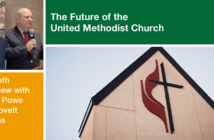It was recently announced that 26 U.S.-based Annual Conferences paid 100 percent of their general church apportionments in 2018. Lovett H. Weems, Jr., draws upon Lewis Center research to explain how some conferences are able to do this and what the implications are for all conferences.
How Do Conferences Pay 100 Percent of General Church Apportionments?
A recent United Methodist News Service story by Heather Hahn reports that 26 Annual Conferences in the U.S. paid 100 percent of their general church apportionments in 2018. This number has remained relatively stable. (A recent high was 29 conferences in 2017.) Despite the denominational anxiety present in 2018, the payout performance was still relatively strong by historical patterns.
While the list of conferences that pay 100 percent changes each year, there is a core of conferences that consistently make the list. It is quite an accomplishment for any conference, and it is does not depend on every congregation in a conference paying 100 percent of their apportionments. In fact, very few local churches raise 100 percent of their own budgets each year. This doesn’t mean that most churches run deficits. It means that congregations have come to expect that they will raise most but not all of the money in the projected budget and they understand that carefully monitoring their expenses will leave enough unspent funds to cover the shortfall.
How do so many conferences achieve this lofty and worthy goal? The Lewis Center for Church Leadership studied the conferences paying 100 percent of general church apportionments for the year 2015. This was done in preparation for a presentation I made to a meeting of the annual conference treasurers. With the help of treasurers from almost two-thirds of the 100 percent conferences, several findings emerged about how conferences achieve this goal.
Observations about 100 Percent Conferences
- Special funding or practices are necessary.
- Conference financial health is not the primary factor. In fact, only half of the 100 percent conferences in 2015 were in relatively strong financial health, while the other half were in relatively poor financial health.
- Two primary factors are conference policies and tradition.
- Conferences that apportion the local churches using one figure rather than line items have an easier time paying 100 percent.
- A high payout rate by churches helps, but this does not determine whether a conference pays 100 percent. The 100 percent conferences had local church payout rates ranging from about 84 percent to as high as 95 percent.
Using these observations, it appears that paying 100 percent would be an option for all except about a dozen conferences provided they were willing to do what some of the 100 percent conferences do. Three methods were identified as the most successful ones to employ. Most of the 100 percent conferences used a combination of these methods.
- Use unspent funds in operating budget line items – used by about two-thirds of the conferences.
- Draw from reserve funds – used by about half of the conferences.
- Apportion higher amounts for local churches in order to collect 100 percent – used by about one-quarter of the conferences. One conference does not raise apportionments but has a higher “challenge” goal that about half the churches choose to pay.
How Likely Is It that Conferences Can Sustain 100 Percent?
Based on conference attendance and financial trends, the Lewis Center projected that there was a high likelihood that half of the 2015 conferences paying 100 percent of general church apportionments would continue this pattern, and there was a medium likelihood that another 30 percent would continue to pay 100 percent. Those research projections are borne out by the 2018 announcement that shows that 73 percent of the 2015 100 percent conferences repeated that achievement in 2018.
What Does This Mean for Annual Conference Leaders?
For conferences that can pay 100 percent of general church apportionments by using current and accepted conference policies and practices, there is probably no reason to make any changes. However, other conferences are not likely to meet their 100 percent general church apportionment goal by more insistently promoting payment of local church apportionments, just as the local church is unlikely to meet its yearly budget through its end-of-the-year appeals. Such appeals may bring in enough to pay the bills without raising enough to achieve all that the budget makers anticipated.
If your conference does not achieve full payout of your general conference apportioned funds, you can try to implement the methods used by the 100 percent conferences. But today’s climate may make such changes difficult. If these methods are not appropriate in your case, it may be more productive to develop different approaches.
Some conferences will focus on how many churches pay 100 percent of their apportionments. However, it is more relevant to consider which churches are paying full apportionments. Having more churches that pay fully does not always mean raising more dollars. Many remember when conferences set “every church” goals for professions of faith such as “every church will have at least one profession of faith.” Should not the goal be to have “more professions of faith,” no matter the churches from which they come? How does this apply to churches paying their apportionments?
Churches that have not fully paid their apportionments in the past 10 years are the least likely candidates to pay 100 percent in the coming year. If these churches are large churches with large apportionments, it may be work the effort to move them along toward paying 100%. But it may hold more promise to look for the churches that have shown the most extravagant generosity. These churches are the ones who may be open to investing more significantly in outreach by supporting conference and general church ministries.




